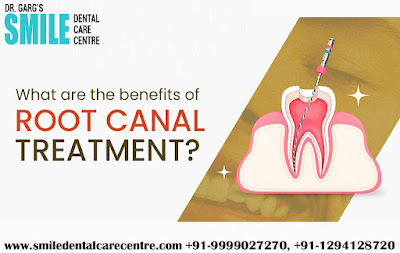Painless Root Canal Treatment Procedures
Starting Procedure Of Painless Root Canal Treatment
A regular dentist or an Endodontist often
performs a root canal. The procedure typically requires one or two visits, but
occasionally more are needed since some teeth are challenging to treat. During
the surgery, a local anaesthetic is also administered to you to lessen pain.
The tooth is then covered with a dental dam, which is made to resemble rubber,
to keep it safe, clean, and saliva-free. In order to access the pulp chamber,
decay is removed, and the tooth's crown is cut apart. The damaged or infected
pulp is removed using tiny dental tools.
Root Canal Infection Clearing From The Mouth
The pulp chamber and root canals are flushed
and cleansed once the infected pulp has been eliminated. In order to provide
better access for filling, the root canals may be altered and lengthened. The
root canals are disinfected and dried before being permanently filled. To treat
any infection, medication is occasionally injected into the pulp chamber and
root canals. You might require a prescription for antibiotics if the infection
has moved outside of the tooth. A temporary filling of root canal is put in the
crown after root canal therapy to safeguard the tooth by the dentist and keep
saliva and debris out. You should not chew or bite on the tooth, until your
teeth do not become permanent and restoration. Check:
Procedure Of Filling The Root Canals
The pulp chamber and root canals need to be
filled once the tooth has been cleaned and dried. This phase might not require
any extra anaesthesia. The temporary filling, if any, will be taken out to give
access to the interior of the tooth. To ensure that the root canals are
shielded from saliva, the tooth is first filled with a sealer paste and rubber
compound.
Final Stage Of Painless Root Canal Treatment Procedure
The restoration of your tooth completes the
root canal procedure. The tooth which you are getting treatment needs to be
shielded. It will harm and restored to normal function since it often has a
large filling or is weak from severe decay. This is typically accomplished by
covering your tooth with a crown, an artificial tooth that looks natural.
Although various materials may be used, a crown is often constructed of gold,
porcelain, or porcelain fused to metal. To match the colour of your existing
teeth, porcelain or porcelain fused to metal crowns can be coloured. If there
is a large amount of tooth structure missing, it may be necessary to first
install a metal post in the tooth for structural support and to keep the crown
in place. Inquire about more restoration possibilities with your dentist or
Endodontist.
What After Root Canal
Following a root canal, your tooth should be functionally and aesthetically restored with a new crown. Your restored tooth might last a lifetime if you practise appropriate dental and oral care. The tooth may be sensitive in the first couple of days following your root canal. Pain killers that are not prescribed may be helpful. See your dentist or Endodontist if pain or pressure persists for more than a few days. Check: Painless Root Canal Treatment in Faridabad
Our Other Services







Comments
Post a Comment